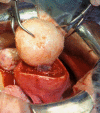Fertility and Pregnancy Outcome after Myoma Enucleation by Minilaparotomy under Microsurgical Conditions in Pronounced Uterus Myomatosus
- PMID: 25684787
- PMCID: PMC4318730
- DOI: 10.1055/s-0034-1396163
Fertility and Pregnancy Outcome after Myoma Enucleation by Minilaparotomy under Microsurgical Conditions in Pronounced Uterus Myomatosus
Abstract
Introduction: Besides the typical complaints and symptoms, myomas can cause sterility, infertility and complications during pregnancy. Laparoscopic interventions reach their limits with regard to organ preservation and the simultaneous desire to have children in the removal of multiple and larger intramural myoma nodes. The aim of this study is to examine fertility status and pregnancy outcome after myoma removal by minilaparotomy (skin incision maximal 8 cm) in women with pronounced uterus myomatosus. Materials and Methods: This retrospective study makes use of the data from 160 patients with an average age of 34.6 years. Factors analysed include number, size and localisation of the myomas, complaints due to the myoma, pre- and postoperative gravidity, mode of delivery, and complications of birth. Results: Indications for organ-sparing myoma enucleation were the desire to have children (72.5 %), bleeding disorders (60 %) and pressure discomfort (36.5 %). On average 4.95 (SD ± 0.41), maximally 46 myomas were removed. The largest myoma had a diameter of 6.64 cm (SD ± 2.74). 82.5 % of the patients had transmural myomas, in 17.5 % the uterine cavity was inadvertently opened. On average the operating time was 163 minutes (SD ± 45.47), the blood loss 1.59 g/dL (SD ± 0.955). 60.3 % of the patients with the desire to have children became pregnant postoperatively. 75.3 % of the pregnancies were on average carried through to the 38th week (28.4 % vaginal deliveries, 71.6 % Caesarean sections). In the postoperative period there was one case of uterine rupture in the vicinity of a previous scar. Discussion: By means of the microsurgical "mini-laparotomy" even extensive myomatous uterine changes can, in the majority of cases, be operated in an organ-sparing manner with retention of the ability to conceive and to carry a pregnancy through to maturity of the infant. The risk for a postoperative uterine rupture in a subsequent pregnancy and during delivery is minimal.
Einleitung: Myome können neben typischen Beschwerden und Symptomen Sterilität, Infertilität und Schwangerschaftskomplikationen verursachen. Laparoskopische Eingriffe stoßen bei der Entfernung multipler und großer intramuraler Myomknoten bez. der Organerhaltung bei vorhandenem Kinderwunsch an ihre Grenzen. Ziel der Arbeit ist, das Fertilitätsvermögen und Schwangerschaftsoutcome nach Myomentfernung per Minilaparotomie (Hautinzision max. 8 cm) bei Frauen mit ausgeprägtem Uterus myomatosus zu untersuchen. Material und Methodik: Die retrospektive Arbeit beinhaltet Daten von 160 Patientinnen mit einem mittleren Alter von 34,6 Jahren. Analysiert wurden Zahl, Größe und Lage der Myome, myombedingte Beschwerden, prä- und postoperative Graviditäten, Entbindungsmodus und Geburtskomplikationen. Ergebnisse: Indikationen zur konservierenden Myomenukleation waren Kinderwunsch (72,5 %), Blutungsstörungen (60 %) und Druckbeschwerden (36,5 %). Im Mittel wurden 4,95 (SD ± 0,41), max. 46 Myome entfernt. Der größte Myomdurchmesser betrug 6,64 cm (SD ± 2,74). In 82,5 % lagen transmurale Myome vor, in 17,5 % wurde das Cavum uteri intraoperativ ungewollt eröffnet. Die Operationsdauer betrug durchschnittlich 163 min (SD ± 45,47), der Blutverlust 1,59 g/dl (SD ± 0,955). 60,3 % der Kinderwunschpatientinnen wurden postoperativ schwanger. 75,3 % der Schwangerschaften wurden im Mittel bis zur 38. SSW ausgetragen (28,4 % vaginale Geburt, 71,6 % Sectiones). Postoperativ trat einmal eine Uterusruptur im Bereich einer alten Sectionarbe auf. Diskussion: Mittels mikrochirurgischer „Mini-Laparotomie“ lassen sich selbst erhebliche myomatöse Uterusveränderungen organerhaltend operieren und die Konzeptionsfähigkeit sowie das Vermögen, eine Schwangerschaft bis zur Reife des Kindes auszutragen, in hohem Maße wiederherstellen. Das Risiko für postoperative Uterusrupturen in graviditate und während der Geburt ist minimal.
Keywords: microsurgery; minilaparotomy; myoma; myoma enucleation; pregnancy outcome; sterility.
Conflict of interest statement
Figures




Similar articles
-
Duration of Sick Leave, Patient's Postoperative Satisfaction and Impairment of Daily Living after Open Abdominal Myoma Enucleation in Dependence on Myoma Size.Geburtshilfe Frauenheilkd. 2015 May;75(5):450-455. doi: 10.1055/s-0035-1546051. Geburtshilfe Frauenheilkd. 2015. PMID: 26097248 Free PMC article.
-
[Ability to conceive and the course of pregnancy in women after laparoscopic myomectomy].Przegl Lek. 2004;61(2):65-9. Przegl Lek. 2004. PMID: 15230143 Polish.
-
Fertility after laparoscopic myomectomy of large uterine myomas: operative technique and preliminary results.Eur J Gynaecol Oncol. 2003;24(1):79-82. Eur J Gynaecol Oncol. 2003. PMID: 12691325
-
Pregnancy Outcomes After Direct Uterine Myoma Thermal Ablation: Review of the Literature.J Minim Invasive Gynecol. 2017 May-Jun;24(4):538-545. doi: 10.1016/j.jmig.2017.01.009. Epub 2017 Jan 18. J Minim Invasive Gynecol. 2017. PMID: 28109894 Review.
-
Rapidly growing uterine myoma - should we be afraid of it?Prz Menopauzalny. 2023 Sep;22(3):161-164. doi: 10.5114/pm.2023.131497. Epub 2023 Sep 25. Prz Menopauzalny. 2023. PMID: 37829270 Free PMC article. Review.
Cited by
-
Diagnostic Office Vaginohysteroscopy in Evaluation of Infertility Prior to IVF: A Retrospective Analysis of 1000 Cases.J Obstet Gynaecol India. 2017 Aug;67(4):275-281. doi: 10.1007/s13224-017-0972-9. Epub 2017 Feb 10. J Obstet Gynaecol India. 2017. PMID: 28706367 Free PMC article.
References
-
- McCool W F, Durain D, Davis M. Overview of latest evidence on uterine fibroids. Nurs Womens Health. 2014;18:314–332. - PubMed
-
- Fernandez H. Uterine fibroids. Rev Prat. 2014;64:540–544. - PubMed
-
- Koivisto-Korander R, Martinsen J I, Weiderpass E. et al.Incidence of uterine leiomyosarcoma and endometrial stromal sarcoma in Nordic countries: results from NORDCAN and NOCCA databases. Maturitas. 2012;72:56–60. - PubMed
-
- Parker W H, Fu Y S, Berek J S. Uterine sarcoma in patients operated on for presumed leiomyoma and rapidly growing leiomyoma. Obstet Gynecol. 1994;83:414–418. - PubMed
-
- Luciano A A. Myomectomy. Clin Obstet Gynecol. 2009;52:362–371. - PubMed
LinkOut - more resources
Full Text Sources
Other Literature Sources

